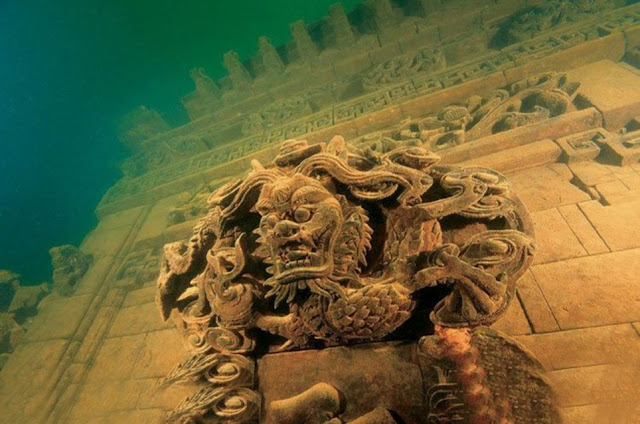A maze of white temples, memorial arches, paved roads, and houses... hidden 130 feet underwater: this is China's real-life Atlantis.
The so-called Lion City, tucked in a lake between the Five Lion Mountain, was once Shi Cheng - the centre of politics and economics in the eastern province of Zhejiang.
But in 1959, the Chinese government decided a new hydroelectric power station was required - so built a man-made lake.
The so-called Lion City, tucked in a lake between the Five Lion Mountain, was once Shi Cheng - the centre of politics and economics in the eastern province of Zhejiang.
But in 1959, the Chinese government decided a new hydroelectric power station was required - so built a man-made lake.
Unlike the mythical Atlantis, Shicheng – which means Lion City in Mandarin – was purposely flooded in 1959 to make way for the Xin’an Dam and its adjoining hydroelectric station. Nearly 300,000 people were relocated for the project, some of whom had families that had lived in the city for centuries.
The city was “rediscovered” in 2001 when the Chinese government organised an expedition to see what might remain of the lost metropolis. Interest and exploration increased further in 2011, when the Chinese National Geography published some never-before-seen photographs and illustrations hypothesising what the small city, which measured about half a square kilometre, might have looked like in its heyday.
Expeditions and underwater photographs have revealed that the city had five entrance gates, as opposed to the traditional four – with two western-facing gates as well as gates in the other cardinal directions. The city’s wide streets also have 265 archways, featuring preserved stonework of lions, dragons, phoenixes and historical inscriptions, some of which date back as far as 1777; the city walls are believed to date back to the 16th Century.
Despite being underwater, Shicheng has remained well preserved; the water actually protects it from wind, rain and sun erosion. Today, advanced divers can get up close to the ruins with dive operators such as Big Blue and Zi Ao Diving Club, which run regular dives between April and November. Since the ruins have yet to be fully mapped, the dive is still considered “Exploratory” and is limited to divers with deep water, night and buoyancy experience.




